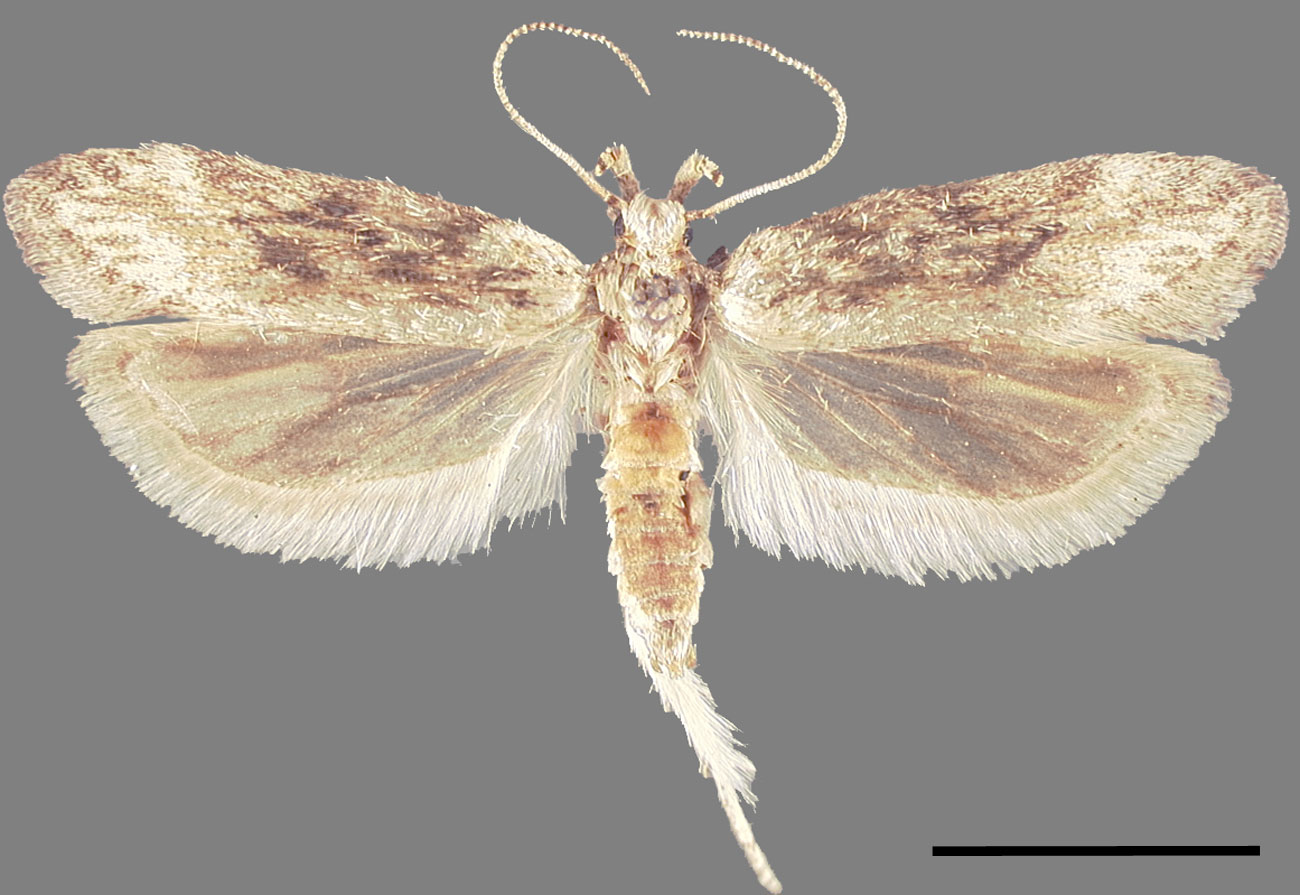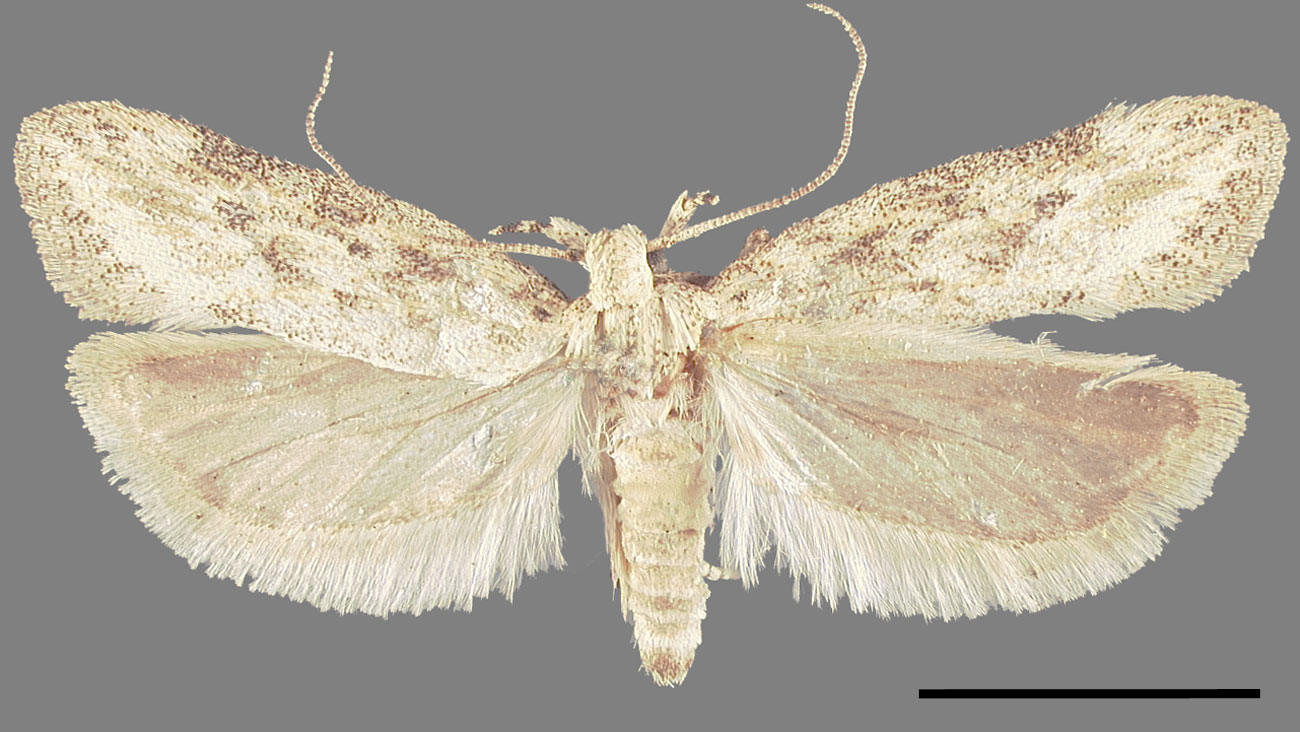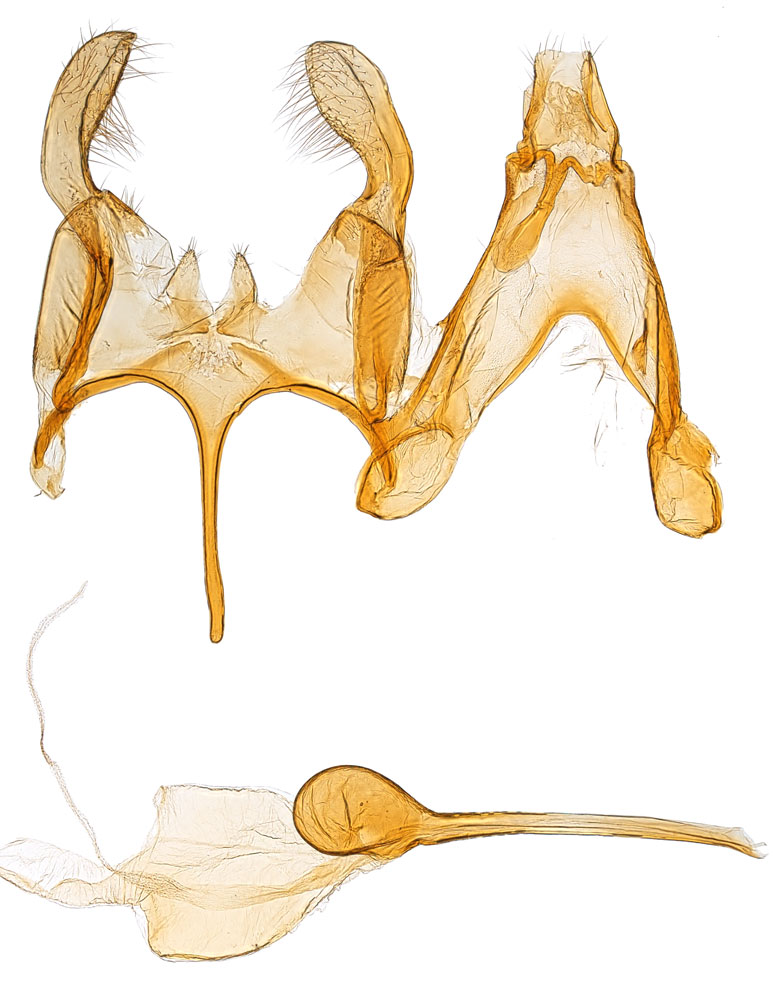Frumenta nundinella
|
Frumenta nundinella male habitus. Scale = 5 mm. |
|
Frumenta nundinella female habitus. Scale = 5 mm. |
|
Frumenta nundinella head. |
|
Frumenta nundinella male genitalia. |
|
Frumenta nundinella female genitalia. |
Name
Frumenta nundinella (Zeller, 1873)
Common name: none
Original combination: Gelechia nundinella Zeller, 1873
Synonyms: Gelechia beneficentella Murtfeldt, 1881
Alternative combinations: Frumenta beneficentella (Murtfeldt, 1881)
Classification: Gelechioidea: Gelechiidae: Gelechiinae: Gnorimoschemini
Adult recognition
Adults are about 7.5–9.0 mm in forewing length. They are yellowish white mottled with predominantly dark gray and sparse orange-brown scales that tend to be arranged in narrow, inconspicuous longitudinal rows. The labial palpusLabial palpus:
The more prominent, elongate pair of appendages on the head, usually three-segmented (pl. palpi).
-800px.jpg) is upturned. The hindwing is grayish yellow or light gray, with a subrectangular, rounded apex and a long fringe of hairs. The abdomen has dense, white scales at the base of the dorsal surface of the first segment and yellowish orange scales on the dorsal surfaces of the first three segments. The male genitalia have an elongate, spatulate-shaped gnathosGnathos:
is upturned. The hindwing is grayish yellow or light gray, with a subrectangular, rounded apex and a long fringe of hairs. The abdomen has dense, white scales at the base of the dorsal surface of the first segment and yellowish orange scales on the dorsal surfaces of the first three segments. The male genitalia have an elongate, spatulate-shaped gnathosGnathos:
A variously shaped bridge-like structure, usually hooked or bowed, crossing the tegumen below the uncus.
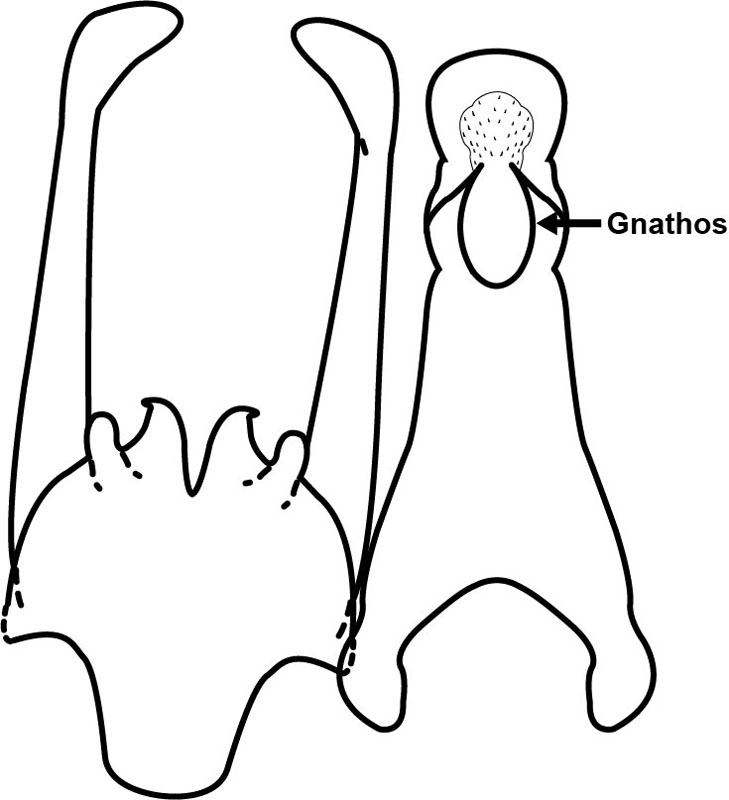 and a vinculumVinculum:
and a vinculumVinculum:
The ventral half of the male genitalia, from which the valvae arise.
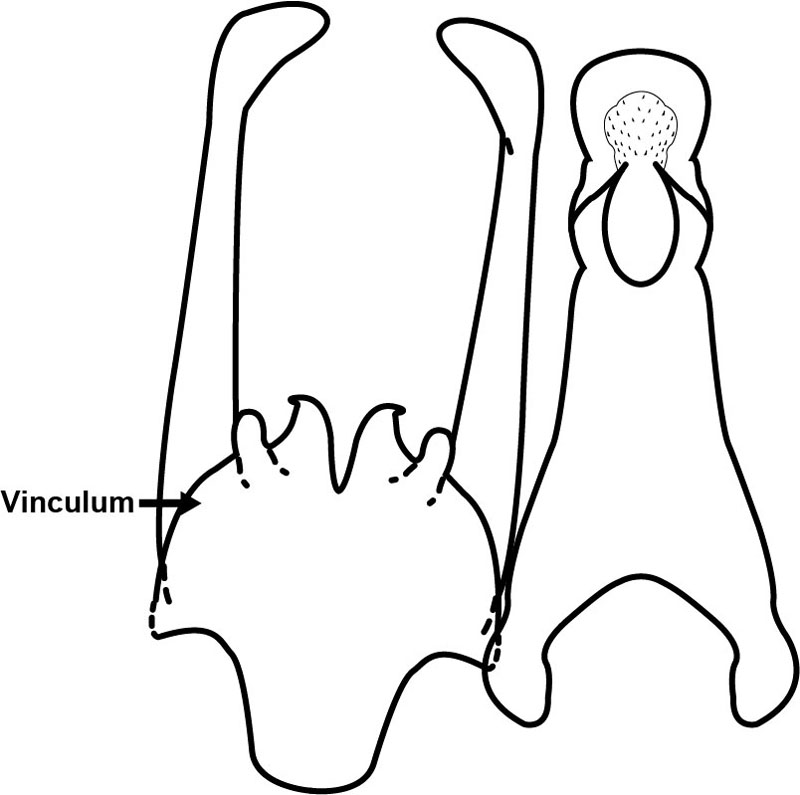 with paired short and stout hairy triangular-shaped processes. Females have a narrow ductus bursaeDuctus bursae:
with paired short and stout hairy triangular-shaped processes. Females have a narrow ductus bursaeDuctus bursae:
The usually narrow duct between the ostium and antrum and the corpus bursae.
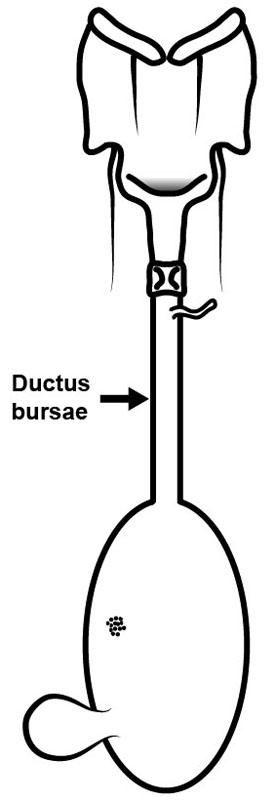 nearly as long as corpus bursaeCorpus bursae:
nearly as long as corpus bursaeCorpus bursae:
The enlarged, bulbous anterior end of the female genitalia.
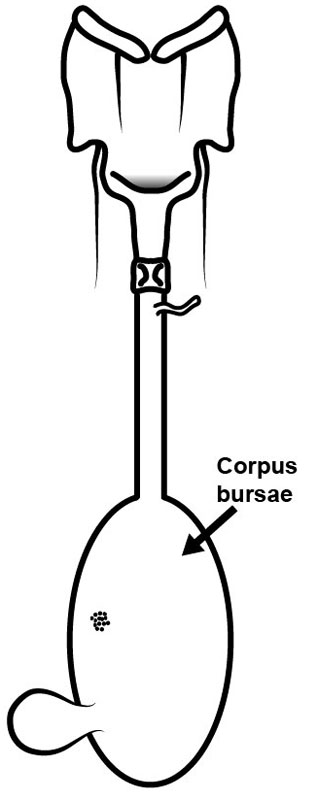 and a small and stubby signumSignum:
and a small and stubby signumSignum:
Any sclerite, sclerotized area, or discrete granular area on the wall of the corpus bursae (pl. signa).
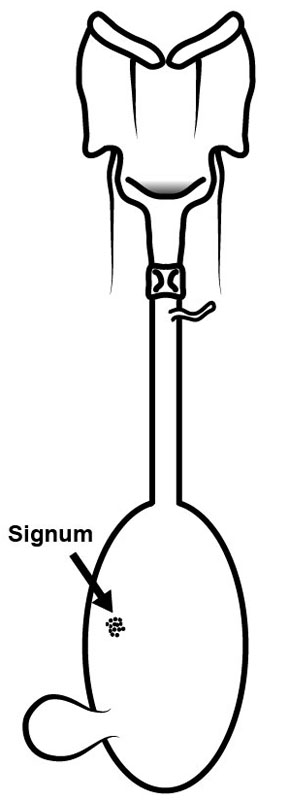 with a blunt apex.
with a blunt apex.
Immature stages
Larvae when fully grown are about 12–15 mm long. The head is black when young, later assuming an olive brown hue. The prothoracic shieldProthoracic shield:
Also called the T1 shield. In the larva, the extensive sclerotized area of the dorsal half of the prothorax. It bears six setae on each side, and its color pattern is often diagnostic.
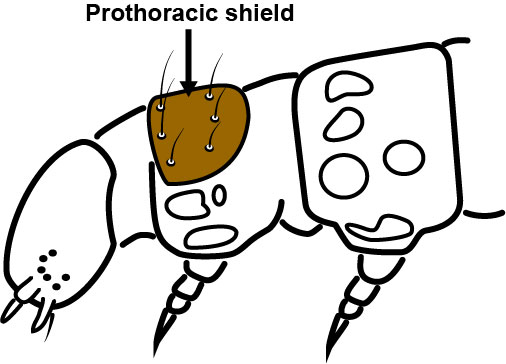 is not banded, the thoracic legs are usually not pigmented and the body has pale brown pinacula. No detailed morphological information on the mouthparts or chaetotaxyChaetotaxy:
is not banded, the thoracic legs are usually not pigmented and the body has pale brown pinacula. No detailed morphological information on the mouthparts or chaetotaxyChaetotaxy:
The pattern of setae on the larva.
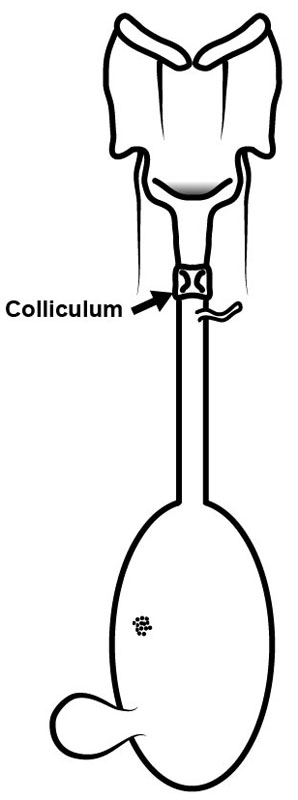 has been published.
has been published.
PDF - Dichotomous key to Gelechiid larvae
Similar species
The adult of F. nundinella is superficially similar to Frumenta solanophaga Adamski and Brown but it differs by having the following genital characters: male valvaValva:
One of the pair of large lateral appendages of the male genitalia (pl. valvae).
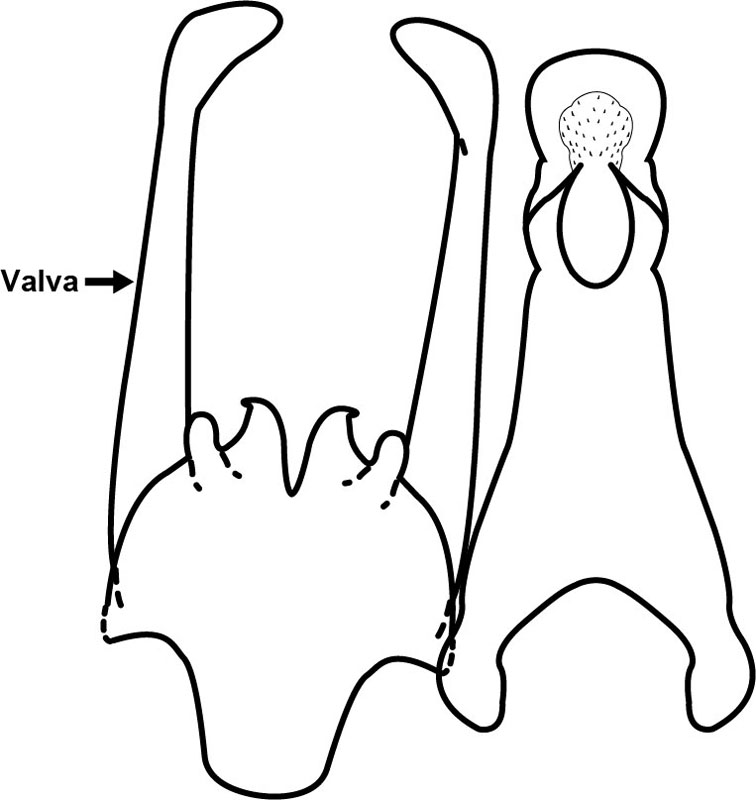 short and thick with a rounded tip and saccusSaccus:
short and thick with a rounded tip and saccusSaccus:
A ventral extension of the vinculum, between the valvae.
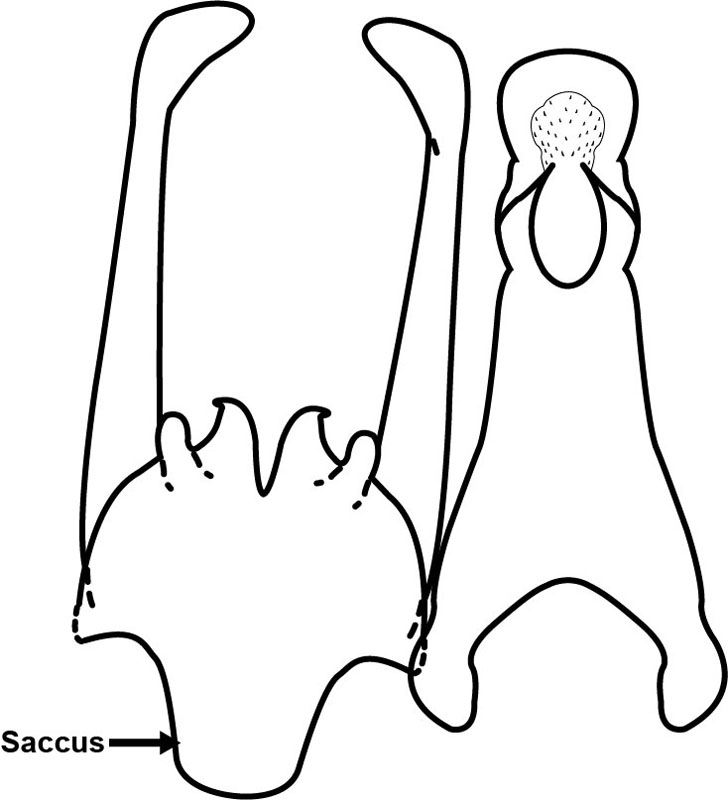 longer than the length of valvaValva:
longer than the length of valvaValva:
One of the pair of large lateral appendages of the male genitalia (pl. valvae).
 . The valvaValva:
. The valvaValva:
One of the pair of large lateral appendages of the male genitalia (pl. valvae).
 of F. solanophaga has a blunt tip and the saccusSaccus:
of F. solanophaga has a blunt tip and the saccusSaccus:
A ventral extension of the vinculum, between the valvae.
 is shorter than the length of valvaValva:
is shorter than the length of valvaValva:
One of the pair of large lateral appendages of the male genitalia (pl. valvae).
 .
.
Among the species included here, the larva of F. nundinella is recognized by the host, distribution and habits. We include four species feeding specifically on Solanum carolinense: F. nundinella, Keiferia lycopersicella, K. inconspicuella and K. glochinella. Frumenta nundinella lacks a posterior band on the prothoraxProthorax:
The first thoracic segment (T1) of any life stage.
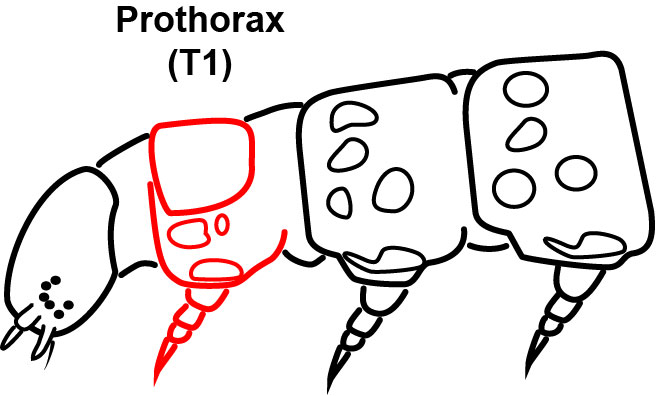 that is present in K. lycopersicella. Keiferia glochinella is a western species whereas F. nundinella occurs in the eastern and midwestern United States. Frumenta nundinella does not mine leaves as is the case with Keiferia lycopersicella, Keiferia inconspicuella and K. glochinella. Phthorimaea operculella may feed on Solanum carolinense, but unlike F. nundinella, the thoracic legs are pigmented.
that is present in K. lycopersicella. Keiferia glochinella is a western species whereas F. nundinella occurs in the eastern and midwestern United States. Frumenta nundinella does not mine leaves as is the case with Keiferia lycopersicella, Keiferia inconspicuella and K. glochinella. Phthorimaea operculella may feed on Solanum carolinense, but unlike F. nundinella, the thoracic legs are pigmented.
Behavior
Eggs are laid on the plant surface with a sticky substance on the egg surface. After eclosing, larvae wander on leaf and stem surfaces until they reach a leaf bud either at the apical growth point or at a leaf joint. Larvae are reported in southwest Virginia to have two generations per year. They are known to attack two stages of host-plant in each generation. First generation larvae feed within leaf chambers before formation of fruits. After formation of fruits, second generation larvae bore into fruits, so they have a greater impact on seed production than leaf damage.
Distribution
Native to North America. USA (throughout southern and midwestern United States), Canada (Ontario).
Hosts
Solanum carolinense L. (Carolina horsenettle)
Comments
This species is known widely as an important herbivore of Solanum carolinense, which is a native weed in the southeastern United States. Biological studies on this species were conducted in the 1970s.
Literature
Adamski and Brown 2002Adamski and Brown 2002:
Adamski D and Brown JW. 2002. A new species of Frumenta Busck (Lepidoptera: Gelechiidae: Gnorimoschemini) from Mexico: A potential biocontrol agent against Solanum elaeagnifolium (Solanaceae). Proceedings of the Entomological Society of Washington 104: 1029-1035.
Bailey 1977Bailey 1977:
Bailey TE. 1977. Recent development in the study of the gelechiid moth, Frumenta nundinella . Virginia Journal of Science 28: 49 (abstract).
Bailey and Kok 1976Bailey and Kok 1976:
Bailey TE and Kok LT. 1976. Occurrence of Frumenta nundinella (Lepidoptera: Gelechiidae) in southwest Virginia, and its potential as a biocontrol agent of horsenettle. Virginia Journal of Science 27: 31 (abstract).
Bailey and Kok 1982Bailey and Kok 1982:
Bailey TE and Kok LT. 1982. Biology of Frumenta nundinella (Lepidoptera: Gelechiidae) on horsenettle in Virginia. Canadian Entomologist 114: 139-144.
Busck 1939Busck 1939:
Busck A. 1939. Restriction of the genus Gelechia (Lepidoptera: Gelechiidae), with descriptions of new genera. Proceedings of the United States National Museum 86: 563-593, pl. 58-71.
Foott 1967Foott 1967:
Foott WH. 1967. Occurrence of Frumenta nundinella (Lepidoptera: Gelechiidae) in Canada. Canadian Entomologist 99: 443-444.
Murtfeldt 1881Murtfeldt 1881:
Murtfeldt ME. 1881. New species of Tineidae. Canadian Entomologist 13: 242-246.
Solomon 1980Solomon 1980:
Solomon BP. 1980. Frumenta nundinella (Lepidoptera: Gelechiidae): Life history and induction of host parthenocarpy. Environmental Entomology 9: 821-825.
Solomon 1988Solomon 1988:
Solomon BP. 1988. Infestation of Solanum carolinese fruit by Frumenta nundinella : Are larvae affected by interfruit competition? American Midland Naturalist 119: 714.
Zeller 1873Zeller 1873:
Zeller PC. 1873. Beitrauml;ge zur Kenntniss der nordamericanischen Nachtfalter, besonders der Microlepidopteren. Verhandlungen der Kaiserlich-Kouml;niglichen Zoologisch-Botanischen Gesellschaft in Wien 23: 201-334, Taf. III-VI.

